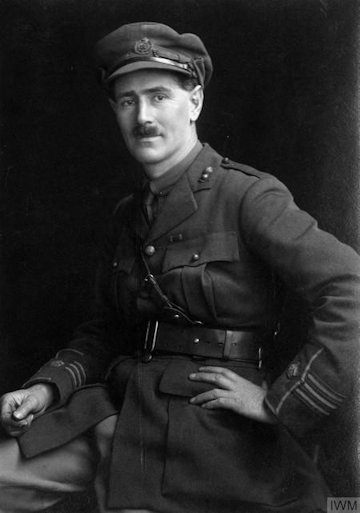
Major
ARCHIBALD
ALDERMAN CHASE, D.S.O.
Royal Engineers
By
Lieutenant Colonel (Retired) Edward De Santis,
MSCE, PE, MinstRE
(August 2023)

Figure 1. Major Archibald Alderman Chase,
D.S.O., R.E.
(Image courtesy of the Imperial War Museum)
1. INTRODUCTION
The principal references used in the preparation of this narrative were from a number of sources. They include a family tree, military histories and documents, the London Gazette, the Royal Engineers Journal and other documents. All sources are contained in the REFERENCE section at the end of the narrative and are cited throughout in the ENDNOTES. Every effort has been made to accurately portray the military service of Major Chase.
Family Information
Archibald Alderman Chase was born in Jamalpur,[1] India on 16 September 1884. He was the third son of William Hackett Chase (1849-1903) and Priscilla Jane Chase, née Matthews (1850-1920).[2]
Education
Chase attended Bedford Modern School and then the Royal Military Academy at Woolwich, where he earned the King Edward’s Gold Medal for obtaining high marks in his military subjects.[3]
3. COMMISSIONING AND TRAINING
Commissioning
Upon his graduation from Woolwich on 29 July 1904, Chase was commissioned a 2nd Lieutenant in the Corps of Royal Engineers[4] and was posted to the School of Military Engineering (S.M.E.) at Chatham for officer training.
Training
At the S.M.E., 2nd Lieutenant Chase, or “Ginger” as he was known, received instruction in field Fortifications, construction, surveying, telegraphy, electric lighting, submarine mining, photography, chemistry, military law and tactics. The course of instruction lasted for about two years, from 1904-1906.
While at Chatham, Chase was a member of the crew of the Royal Engineers Yacht Club racing team, the R.E. eight of 1905.[5]
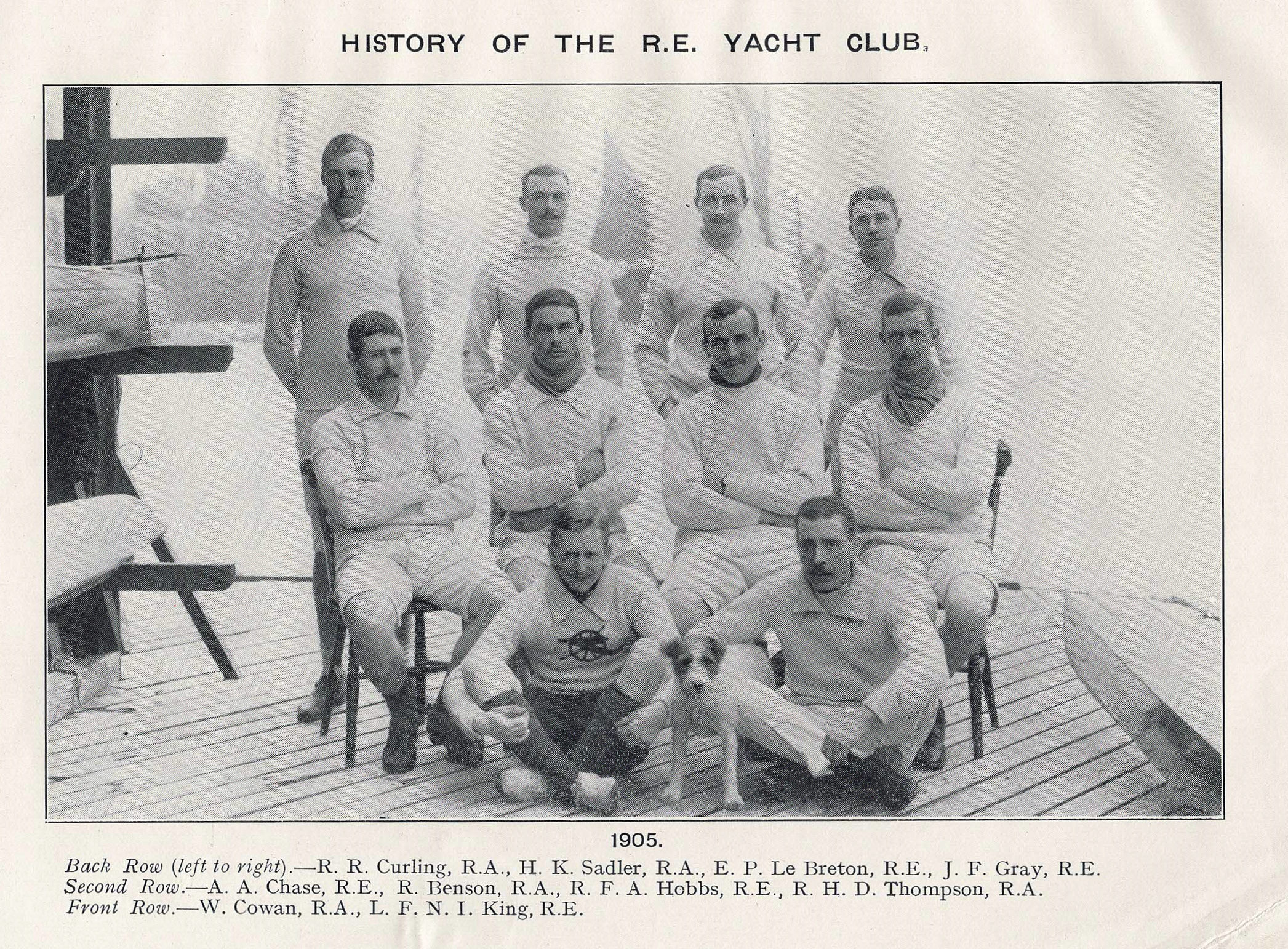
Figure 2. The R.E. Eight of 1905.
(Image
from the Royal Engineers Journal of March 1933)[6]
4. POSTINGS AND CAMPAIGN SERVICE
India (1907-1914)
After about two years at Chatham, Chase was sent to India where he held a number of posts. On 23 March 1907 he was promoted to the rank of Lieutenant. From January to July 1908 he served as the Garrison Engineer at the Ishapore Factory in Ishapore. In 1904, a rifle factory was established by the British at Ishapore, and began production of the Lee–Enfield rifle. As the Garrison Engineer, Chase was responsible for the construction and/or installation of facilities for the garrison and the arms factory at Ishapore.
In August of 1908 he was posted as an Assistant Superintendent, 2nd grade, with the Survey of India in Calcutta.[7] From January to June 1910 he held the same position with the Survey of India, only in Rawalpindi and from July 1910 through December 1912 he served in that capacity with the Survey in Mussoorie. He went to England on 2 November 1911 on leave and he returned to duty in India on 2 February 1912.[8] In 1914 he was posted to Dehra Dun.[9] Shortly after the outbreak of the Great War of 1914-1915 he was attached to an Indian cavalry regiment as a Survey Officer.
On 28 March 1910 Lieutenant Chase married Gladys Maude Waller in Delhi.[10]
France (1914-1917)
When the Great War broke out in August of 1914 Lieutenant Chase still was serving as a Survey Officer in the 1st Indian Cavalry Division. The following excerpt from the Royal Engineers Journal of March 1926 discusses the deployment of the division to France (bold type added for emphasis):
“On 7 November 1914, the 1st Indian Cavalry Division landed at Marseilles and concentrated at Orleans on November 15th . They were accompanied by the 2nd Indian Field Troop (Captain E. K. Molesworth and Lieutenant T. B. Harris[11]) and consisted of men drawn from the 2nd (Queen Victoria’s Own) Sappers and Miners at Bangalore; the equipment had been obtained from the 3rd Sappers and Miners, and the men were mounted in Indian tongas belonging to the Gwalior Transport Corps. The Troop had mobilised at Bangalore on 18 September and left Bombay on 16 October. In accordance with the Indian organization, a Commander Royal Engineers (C.R.E.) with several Field and Assistant Field Engineers accompanied the Division (Colonel C. E. Baddeley, Majors G. A. Leslie and A. G. Bremner, Captains A. R. C. Sanders and E. K. Squires and Lieutenant A. A. Chase, Survey Officer). The Division reached Auchel on November 30th .
On the formation of the Indian Cavalry Corps it was decided to abolish the Indian organization of R.E. with Cavalry, and to adopt the British system. Accordingly the C.R.E.'s, Field and Assistant Field Engineers were dispersed and the formation of two Indian Field Squadrons put in hand, the drivers equipment and wagons to come from England, the sappers from India. On 14 December 1914, Captain W. H. Evans and Lieutenant Nosworthy were sent to Aldershot to collect the British contribution; they arrived in Rouen on 24 December, and joined the Indian Cavalry Corps at Clarques on 2 January 1915. It was found, however, that India was unable to supply any more sappers, and after some delay, Major W. H. Evans and Captain B. H. Fox were sent to Aldershot on 17 March to collect, train and bring out British sappers and the remainder of the equipment; the detachments reached the Corps on 10 and 17 May 1915, after which the formation of the 1st and 2nd Indian Field Squadrons at Wittes and Erny St. Julien was rapidly completed. (1st Squadron with Majors A. G. Bremner and W. H. Evans, Captain A. A. Chase and Lieutenant H. G. Greswell) (2nd Squadron with Major S. D'A Crookshank, Captains D. Ogilvy and B. H. Fox) . The two Indian Field Troops stayed with the Corps until July 1915, when they were broken up and sent to the Indian Infantry Corps.”
Chase was promoted to the rank of Captain on 30 October 1914 while the Indian Cavalry Corps was being formed.[12] In July of 1915, after the field troops in the Indian Cavalry Corps were disbanded, Chase was posted to command the 80th Field Company, R.E. in the British 18th (Eastern) Division. The other engineer units in the division were the 79th and 92nd Field Companies and the 18th Divisional Signal Company. The 8th Battalion, Royal Sussex Regiment was the division’s Pioneer battalion. It frequently worked in conjunction with the R.E. Field Companies to execute field engineering work.
Pioneer Battalions were essentially light military combat engineers organised like the infantry and located at the very forward edge of the battle area. They were used to develop and enhance protection and mobility for supported troops and to deny it to the enemy. They performed engineer field tasks under the supervision of R.E. officers and non-commissioned officers as their own officers and NCOs were not as thoroughly technically trained as the R.E. personnel. The pioneers performed rudimentary tasks and when needed they performed the duties of an infantry battalion in the line.
On 19 August 1915 Chase and his company were at Becourt. Chase was mentioned in the 15 October 1915 despatch of Field Marshal Sir J.D.P. French for gallant and distinguished service in the field. This Mention in Despatches had to have been for his service with the Indian Field Squadron.[13]
The 18th Division did not see much action between August 1915 and July 1916; however, on 14 January 1916 Chase was made a Companion of the Distinguished Service Order (D.S.O.).[14] This exceptional award was bestowed on him shortly after his arrival in France and it is rather curious that he was awarded the D.S.O. at this time. No specific information was uncovered during this research to identify just what he did to earn the D.S.O. as a Captain with so little time in the field. One would have thought that the first award given an officer of Chase’s rank would have been the Military Cross (M.C.), but for some reason he was awarded the D.S.O. for his “gallant and distinguished service in the field.”
From 1 to 13 August the 18th Division and the 80th Field Company saw plenty of action at the Battle of the Somme. Following the offensive on the Somme, Captain Chase and his company were involved in the following actions:[15]
Battle of Bazentin: 14-17 July 1916
The Battle of Bazentin Ridge was part of the Battle of the Somme. On 14 July, the British Fourth Army under General Henry Rawlinson made a dawn attack against the German 2nd Army under General Fritz von Below in the Brown Position (Braune Stellung), from Delville Wood westwards to Bazentin le Petit Wood. During the battle the 18th Division was to set up a defensive flank on the east face of Trônes Wood. The R.E. field companies probably set up obstacles to prevent the German forces for flanking the attacking British battalions.
Battle of Delville Wood: 15 July to 3 September 1916
The Battle of Delville Wood was a series of engagements in the 1916 Battle of the Somme. Delville Wood, was a thick tangle of trees, chiefly beech and hornbeam, with dense hazel thickets, intersected by grassy rides, to the east of Longueval. As part of a general offensive starting on 14 July, which became known as the Battle of Bazentin Ridge (14–17 July), General Douglas Haig intended to capture the German second position between Delville Wood and Bazentin le Petit. On 14–15 July the 18th Division cleared Trônes Wood to the south and a line up to Maltz Horn Farm, adjacent to the French 153rd Division. The R.E. companies would have been used to accompany the attacking brigades to consolidate capture positions.
Battle of Thiepval: 26-28 September 1916
The Battle of Thiepval was the first large offensive of the Reserve Army (Lieutenant General Hubert Gough), during the Battle of the Somme. The attack was intended to benefit from the Fourth Army attack in the Battle of Morval, by starting 24 hours afterwards. The battle was fought on a front from Courcelette in the east, near the Albert–Bapaume road, to Thiepval and the Schwaben Redoubt in the west, which overlooked the German defences further north in the Ancre valley, the rising ground towards Beaumont-Hamel and Serre beyond. Again, the R.E. companies would have been used to accompany the attacking brigades to consolidate capture positions.
Battle of Ancre Heights: 1 October to 11 November 1916
The Battle of Ancre Heights is the name given to the continuation of British attacks after the Battle of Thiepval Ridge from 26 to 28 September during the Battle of the Somme. The battle was conducted by the Reserve Army (renamed Fifth Army on 29 October) from Courcelette near the Albert–Bapaume road, west to Thiepval on Bazentin Ridge. British possession of the heights would deprive the German 1st Army of observation towards Albert to the south-west and give the British observation north over the Ancre valley to the German positions around Beaumont-Hamel, Serre and Beaucourt. The Reserve Army conducted large attacks on 1, 8, 21, and 25 October and from 10 to 11 November.
A brigade of the 18th Division continued the fight for the Schwaben Redoubt on 2 October, when the Germans began a big counter-attack at 0515 hours, from the east end of the redoubt to the old front line south of St. Pierre Divion. After fighting all day, the Germans gained a small amount of ground. At 1000 hours the next morning, a British battalion attempted to bomb their way into Schwaben Redoubt from two directions but bogged down in deep mud. The 18th Division was relieved by the 39th Division on 7 October. Two battalions from the 53rd Brigade of the 18th Division attacked and reached their objectives in Stuff Trench despite a delay at the Courcelette–Grandcourt road, where troops from the 25th Division joined in a bombing fight against a Landwehr unit. During the night of 22 October, the 19th Division relieved the 25th Division and part of the 39th Division sector and the 18th Division moved its left boundary to the Pozières–Miraumont road. Between 26 September and 5 October the 18th Division suffered 3,344 casualties.
Battle of Ancre: 13-18 November 1916
The Battle of Ancre was fought by the British Fifth Army (Lieutenant-General Hubert Gough) against the German 1st Army (General Fritz von Below). The Reserve Army had been renamed the Fifth Army on 30 October. The battle was the last of the big British attacks of the Battle of the Somme. After the Battle of Flers–Courcelette (15–22 September) the Anglo-French armies tried to press their advantage with smaller attacks in quick succession, rather than pausing to regroup and give the Germans time to recover.
During the battle the 39th Division was transferred to the command of II Corps on 2 October and then took over the area south of the Ancre on 5 October, by extending its right boundary to relieve the 18th Division at Thiepval. The 4th Canadian and 18th divisions advanced to take Grandcourt Trench to link with the 19th Division at the east end of Grandcourt. West of the Canadians the 18th Division attacked with the 55th Brigade, which assembled in no man's land in the snow. The 19th Division attacked with two brigades. On the right the 57th Brigade advance reached German positions west of Stump road on the boundary of the 18th Division and pressed on before being cut off and taken prisoner.
During the time that Chase commanded the 80th Field Company (July 1915 – December 1916), his company suffered 15 fatal casualties in the battles indicated above, including one Lieutenant, one 2nd Corporal, one Lance Corporal, eleven Sappers and one Driver (See Annex A).[16]
On 30 November 1916 Captain Chase was appointed to the rank of Acting Major while commanding the 80th Field Company.[17] This appointment was long overdue for him, as he had been commanding the company since July 1915.
In December 1916 Chase was appointed to command the 8th Battalion, Royal Sussex Regiment, the Pioneer Battalion of the 18th Division. He was appointed to replace Lieutenant Colonel A.E. Glasgow who had been selected to command an infantry brigade. One of the first task given to the battalion under Chase’s command was the completion of a light railway to evacuate wounded.[18] This was an extraordinary move for him as a Major in the Royal Engineers being appointed to command what was essentially an infantry battalion. It was a great credit to his competence and performance of duty to have been given this command. Unfortunately, it would shortly cost him his life.
As a result of his new posting as a battalion commander, Chase was promoted Brevet Major on 1 January 1917[19] and then was appointed a Temporary Lieutenant Colonel to command the battalion.[20] While in command of the 8th Royal Sussex (Pioneer) Battalion, the unit took part in operations on the Ancre beginning on 16 January and the action at Miraumont (Boom Ravine) from 17 to 18 February 1917.[21]
Next came preparations for the attack on Irles. Lieutenant Colonel Chase and Lieutenant Colonel H.M. Henderson, R.E.[22] went forward to the line to inspect assembly trenches for the attack on the Loupart line. At 1700 hours on 10 March 1917, while on their way to the trenches, both were wounded close to Irles, near Grandcourt, by an artillery shell. Chase was taken to No. 45 Casualty Clearing Station at “Edgehill” on the Somme, mortally wounded.[23] He died from his wounds at the C.C.S.
The Pioneers of the 8th Royal Sussex had been building a light railway for evacuating wounded in the area of their commander’s death. It was a strange quirk of fate that their much loved commanding officer should have been almost the first to be carried along the line he had prepared.
On the day following his death Acting Lieutenant Colonel Archibald Alderman Chase was buried with full military honours in the military cemetery at Aveluy, France. The funeral service was conducted by The Rev. R. Douglas Canadine, Chaplain to the Forces, with the 8th Royal Sussex Pioneers, who wrote that “he had laid to rest a very gallant soldier and gentlemen.” Chase’s obituary in The Times described him as “the very best type of British Officer in every respect. He was a real leader of men, as well as a thoughtful and most capable staff officer.” Sir Ivor Maxse[24] further commented that Chase “possessed that quality which endeared him to all true soldiers, and did much to the division to which he was attached.” Chase did not retain the rank of Lieutenant Colonel upon his death. He reverted to his permanent rank of Major.
Oddly enough, during the time that Chase commanded the battalion (December 1916 – 10 March 1917) the unit suffered only four fatal casualties, including one Lance Corporal and three Privates (See Annex B).[25]
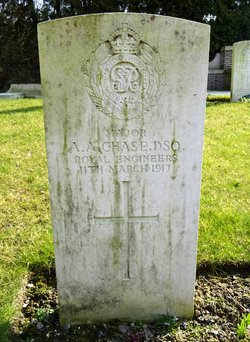
Figure 3. The Grave of Major A.A. Chase, D.S.O.
at Aveluy, France.
(Image courtesy of the Chase family
tree)
It is interesting to note that both his headstone and his memorial in Commonwealth War Graves Commission memorials list him as a Major; that is, he was never granted the substantive rank of Lieutenant Colonel.
_________________________________________________________________________
The following sections provide tabular summaries of Archibald Alderman Chase’s military career.
5. PROMOTIONS AND APPOINTMENTS
Promotions: Chase received the following promotions during his time in service:
Date of Promotion or Appointment |
Rank or Position |
29 July 1904 |
Commissioned a 2nd Lieutenant in the Royal Engineers. |
23 March 1907 |
Promoted Lieutenant. |
30 October 1914 |
Promoted Captain. |
30 November 1916 |
Appointed Temporary Major. |
1 January 1917 |
Promoted Brevet Major. |
11 January 1917 |
Appointed Temporary Lieutenant Colonel. |
Appointments: Chase received the following appointments during his time in service:
Date of Appointment |
|
23 March 1907 |
Appointed Survey Officer in the Indian Cavalry and for the Survey of India. |
10 May 1915 |
Appointed Section Leader in an Indian Field Squadron, Sappers & Miners. |
July 1915 |
Appointed Section Leader in a Royal Engineers Field Company, then Officer Commanding the company. |
December 1916 |
Appointed Officer Commanding, 8th Battalion, Royal Sussex (Pioneers). |
6. MEDALS, AWARDS AND DECORATIONS
As indicated in the narrative, Chase was awarded the D.S.O. on 14 January 1916. For his service during the Great War he was awarded the 1914 Star, British War Medal and Victory Medal with oak leaf emblem for having been mentioned in despatches three times. The types of medals that he was awarded are shown below. These are not Chase’s actual medal, but are presented here for illustrative purposes.
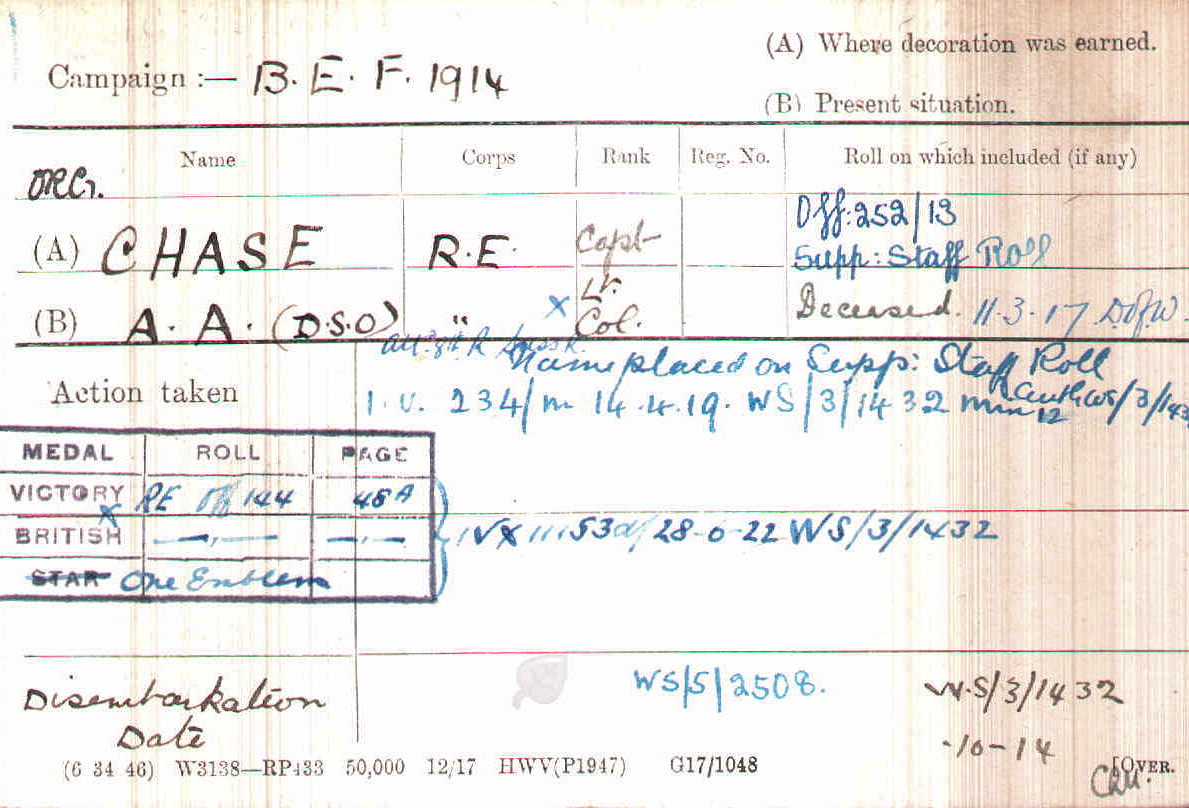
Figure 4. Major Chase’s Medal Index
Card.
(Image courtesy of Ancestry.com)
Chase’s Medal Index Card (M.I.C.) shows that his wife applied for his 1914 Star on 31 January 1918 while she was living at “Hartwell,” on Waterden Road in Guildford, Surrey. The M.I.C. shows that she later moved to 47 Chance Road in Bedford.
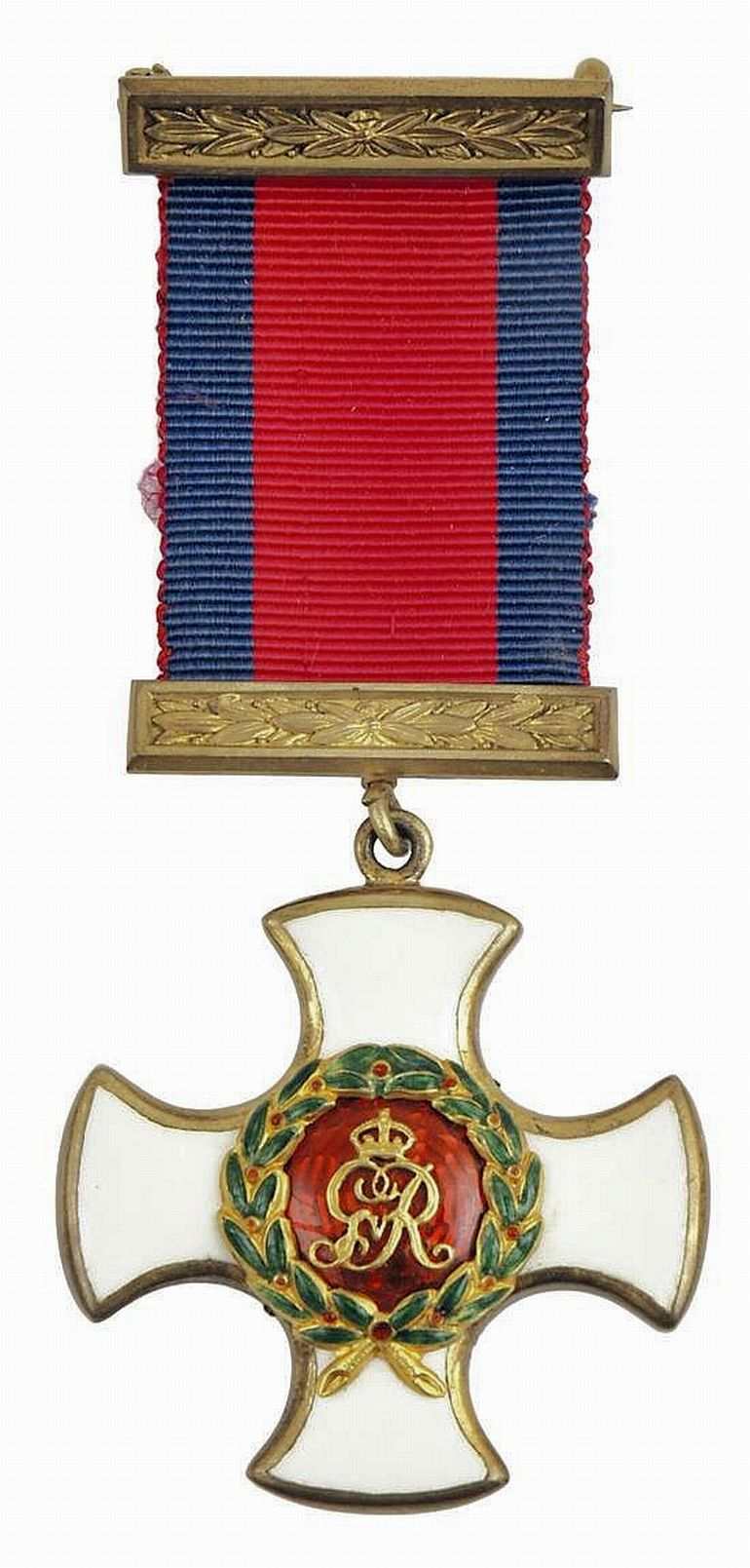
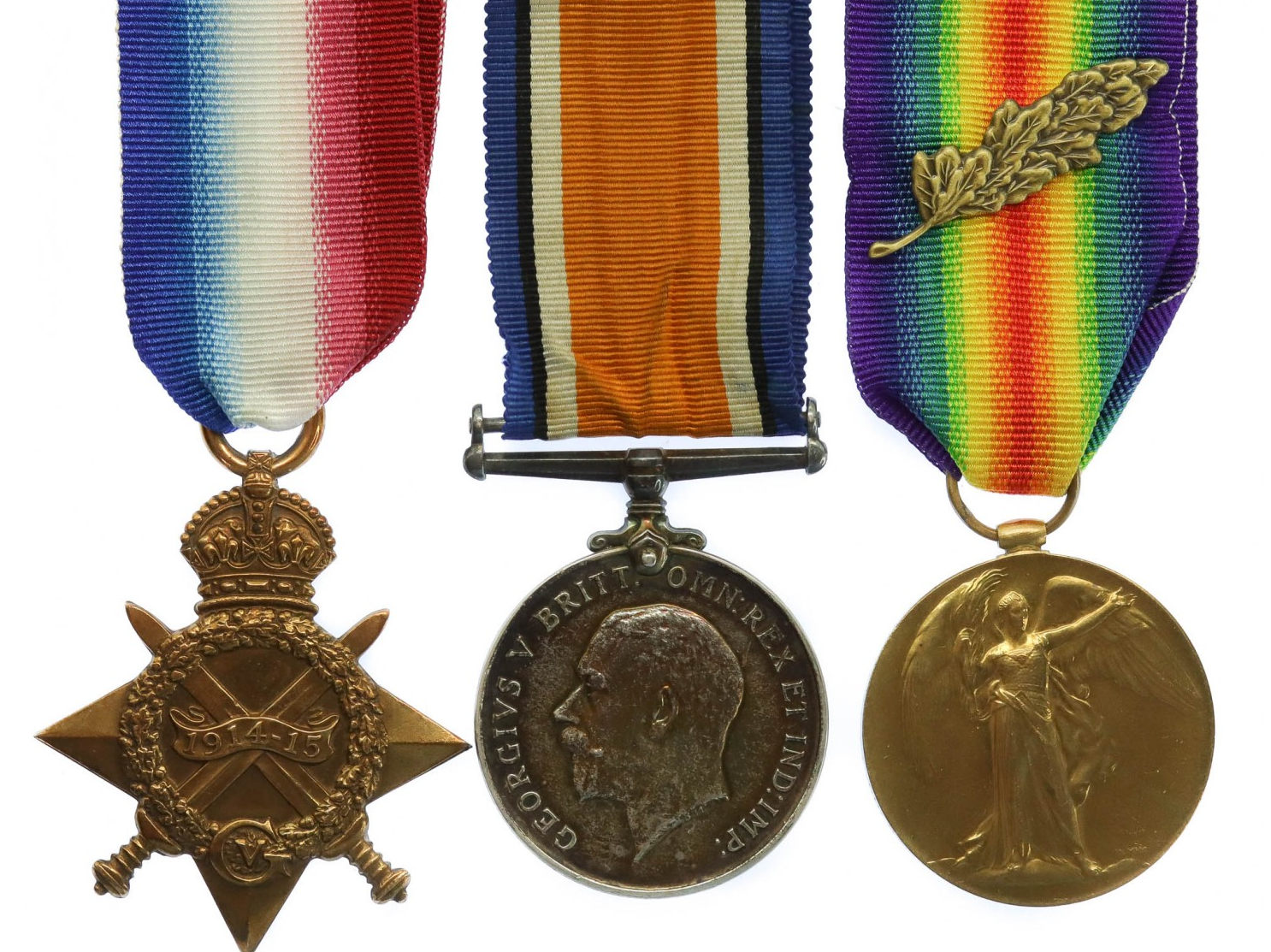
![]()
Figure 5. From left to right: the
Distinguished Service Cross, 1914 Star, British War Medal and Victory
Medal with Mention in Despatches Oak Leave.
(Images from the
author’s collection)
Mrs. Chase also would have received a Memorial Plaque to commemorate his death while on active service. Major Chase’s name would appear in the box over the lion’s head.
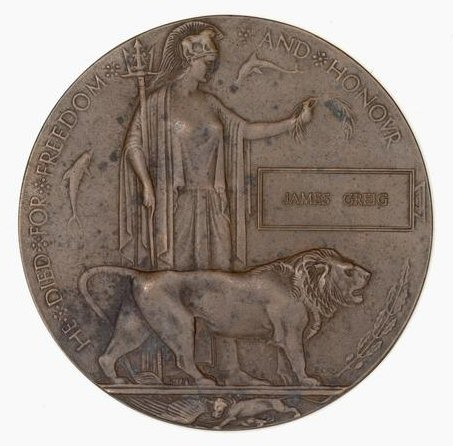
Figure 6. The Memorial Plaque.
(Image
from the author’s collection)
SUMMARY OF SERVICE
The table below provides a summary of the locations of Chase’s military service from 1904 to 1917. Some of the dates under Periods of Service have been estimated.
Location |
|
Chatham, Kent |
29 July 1904 – March 1907 |
Calcutta, India |
March 1907 – January 1908 |
Ishapore, India |
January 1908 – July 1908 |
Calcutta, India |
August 1908 – June 1909 |
Rawal Pindi, India |
June 1909 – June 1910 |
Mussoorie, India |
June 1910 – April 1914 |
Dehra Dun, India |
April 1914 – October 1914 |
France |
October 1914 – 10 March 1917 |
Location |
|
Home Service |
About 2 years and 7 months |
Service Abroad |
About 10 years |
Total Service |
12 years, 7 months and 11 days |
ANNEX A
FATAL CASUALTIES IN THE 80TH FIELD COMPANY, R. E.,July 1915-December 1916 |
||||||
Surname |
Forename |
Initials |
Date of Death |
Rank |
Regimental |
|
PERCIVAL |
JOHN |
J |
27/09/1916 |
Sapper |
134226 |
|
CHRISTIE |
RICHARD COLIN |
R C |
15/12/1915 |
Lieutenant |
||
NEWRICK |
CORNELIUS |
C |
22/10/1915 |
Driver |
50898 |
|
SARGENT |
T H |
30/06/1916 |
Sapper |
97684 |
||
FRANCIS |
GORDON |
G |
1/7/1916 |
Sapper |
59476 |
|
HUGHES |
EDWARD |
E |
5/5/1916 |
Lance Corporal |
61802 |
|
BALDERSTONE |
HENRY HARGREAVE |
H H |
2/11/1916 |
Sapper |
37543 |
|
DODDS |
R |
21/12/1915 |
2nd Corporal |
61801 |
||
SIMPSON |
D |
14/09/1915 |
Sapper |
58469 |
||
MILBURN |
WILLIAM |
W |
1/7/1916 |
Sapper |
47143 |
|
FLEETWOOD |
A |
1/7/1916 |
Sapper |
47150 |
||
BIRKS |
J H |
30/05/1916 |
Sapper |
45331 |
||
MUNNS |
ARTHUR |
A |
30/06/1916 |
Sapper |
97025 |
|
EMUSS |
HAROLD |
H |
1/7/1916 |
Sapper |
46158 |
|
DICKINSON |
JOHN JAMES |
J J |
14/07/1916 |
Sapper |
43672 |
|
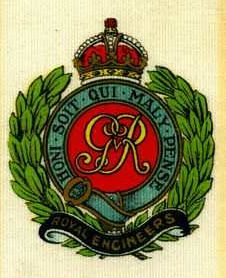
Figure 7. Badge of the Royal Engineers
(Image
courtesy of Wikipedia)
ANNEX B FATAL CASUALTIES IN THE 8TH BN, R. SUSSEX REGIMENT, DEC 1916 - 10 MAR 1917 |
||||||||
Surname |
Given Name |
Initials |
Dated of Death |
Rank |
Regimental |
|||
BANNISTER |
W |
5/2/1917 |
Lance Corporal |
1600 |
||||
PARSONS |
ARTHUR JAMES |
A J |
20/02/1917 |
Private |
G/5683 |
|||
SIMCOX |
E |
31/07/1917 |
Private |
S/335 |
||||
DOBSON |
GEORGE WILLIAM |
G W |
25/02/1917 |
Private |
G/4658 |
|||
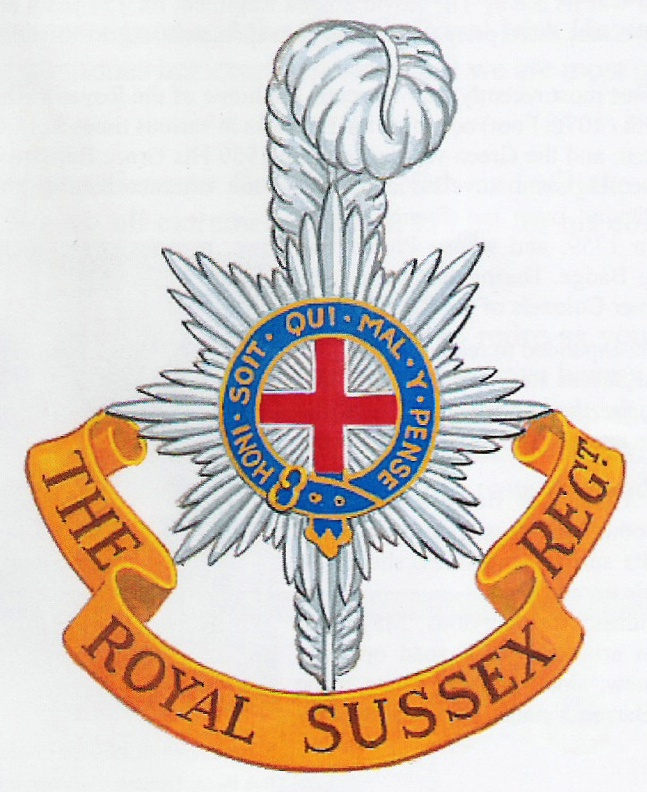
Figure 8. Badge of the Royal Sussex
Regiment.
(Image courtesy of Wikipedia).
REFERENCES:
Army Lists
The Monthly Army List, April 1907.
The Monthly Army List, April 1914.
The Monthly Army List, February 1915.
The Monthly Army List, April 1915.
Hart’s Annual Army List, 1906.
Hart’s Annual Army List, 1915.
Books
BEDFORD MODERN SCHOOL. Roll of Honour, Bedfordshire Modern School, World War 1.
FRENCH, J. Complete Despatches of Lord Franch, 1914-1916.
MASON, K. The War Record 1914-1920. Survey of India, Geodetic Branch Office, 1925.
NICHOLS, G.H.F. The 18th Division in the Great War. William Blackwood and Sons, Edinburgh and London, 1922.
Sandes, E.W.C. The Military Engineer in India, Volume II. The Institution of Royal Engineers, Chatham, Kent, 1935.
Sandes, E.W.C. The Indian Sappers and Miners. The Institution of Royal Engineers, Chatham, Kent, 1948, pp. 454 and 455.
Civil Documents
Probate Calendar, 1917, p. 495.
Family Tree
Archibald Alderman Chase (by sandracole_1)
Internet Web Sites
Imperial War Museum: Major Archibald Alderman Chase.
https://livesofthefirstworldwar.iwm.org.uk/lifestory/786011
Wikipedia: Archibald Alderman Chase.
https://en.wikipedia.org/wiki/Archibald_Alderman_Chase
The Long, Long Trail: 18th (Eastern) Division.
https://www.longlongtrail.co.uk/army/order-of-battle-of-divisions/18th-eastern-division/
8th Battalion Royal Sussex Regiment.
http://battlefields1418.50megs.com/8sussex.htm
London Gazette
London Gazette, 13 September 1904, Issue 27713, p. 5913.
Supplement to the London Gazette, 14 January 1910, p. 575.
The London Gazette, 12 January 1915, p. 380 and 381.
Supplement to the London Gazette, 1 January 1916, p. 23.
Supplement to the London Gazette, 14 January 1916, pp. 571 and 575.
Supplement to the London Gazette, 1 January 1917, p. 18.
Supplement to the London Gazette, 4 January 1917, p. 214.
Supplement to the London Gazette, 27 February 1917, p. 2020.
Supplement to the London Gazette, 19 March 1917, p. 2741.
Military Documents
Medal Index Card.
Mention in Despatches Index Card, London Gazette, 1 January 1916, p. 23 (handwritten card).
Mention in Despatches Index Card, London Gazette, 4 January 1917, p. 214, (handwritten card).
Mention in Despatches Index Card, London Gazette, 4 January 1917, p. 214, (typed card).
Mention in Despatches Index Card, London Gazette, 1 June 1917, p. 5430, (handwritten card)
Mention in Despatches Index Card, London Gazette, 1 June 1917, p. 5430, (typed card).
Periodicals
Obituary in The Guardian, Lieut. Col. A.A. Chase D.S.O. (died of wounds), 20 March 1917, p. 7.
Obituary in The Times, Lieutenant-Colonel Archie Chase D.S.O, 21 March 1917, p. 11.
The Royal Engineers Journal, The Institution of Royal Engineers, Chatham, March 1926.
The Royal Engineers Journal, The Institution of Royal Engineers, Chatham, June 1926.
The Royal Engineers Journal, The Institution of Royal Engineers, Chatham, March 1933.
The Royal Engineers Lists, January – December 1908.
The Royal Engineers Lists, January – December 1910.
The Royal Engineers Lists, January – December 1912.
ENDNOTES:
[1] Jamalpore.
[2] Chase family tree by sandracol-1 on Ancestry.com.
[3] Chase family tree and the Royal Engineers Monthly List, 1908.
[4] London Gazette, 13 September 1904.
[5] The Royal Engineers Journal, March 1933.
[6] Major Julian Frederick (“Dolly”) Gray, M.C. was killed in action in Palestine on 11 July 1918 while in command of the 1st Company, 1st King George’s Own Sappers and Miners.
[7] The Survey of India was established in 1767 to assist the British East India Company in carrying out survey work and to map territory for the purposes of administration, taxation, and defense. By the end of the 19th century, the survey had succeeded in mapping most of British India.
[8] Various editions of the Royal Engineers List.
[9] Hart’s Annual Army List, 1915.
[10] Wikipedia.
[11] Later, Colonel, D.S.O.
[12] London Gazette, 12 January 1915.
[13] London Gazette, 1 January 1916.
[14] London Gazette, 14 January 1916.
[15] Wikipedia web sites.
[16] Commonwealth War Graves Commission.
[17] London Gazette, 19 March 1917. This appointment was made after he died of wounds in March 1917.
[18] 18th Division History.
[19] London Gazette, 1 January 1917.
[20] London Gazette, 27 February 1917.
[21] 8th Battalion Royal Sussex Regiment web site.
[22] Lieutenant Colonel Henderson, a very bold and zealous officer, had only recently joined the division having succeeded Lieutenant Colonel Joly de Lotbiniere as CRE in January on the latter's appointment to the XVIII Corps as Chief Engineer.
[23] 18th Division History.
[24] General Maxse was the commander of VIIII Corps.
[25] Commonwealth War Graves Commission.